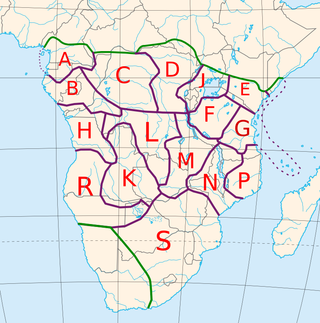
The Bantu languages are a language family of about 600 languages that are spoken by the Bantu peoples of Central, Southern, Eastern and Southeast Africa. They form the largest branch of the Southern Bantoid languages.
Despite Gabon's small population, this Central African country is home to many different Bantu tribes and a small pygmy population.

Benue–Congo is a major branch of the Volta-Congo languages which covers most of Sub-Saharan Africa.
Malcolm Guthrie was an English linguist who specialized in Bantu languages.
Central Kilimanjaro, or Central Chaga, is a Bantu language of Tanzania spoken by the Chaga people.

The Makaa–Njem languages are a group of Bantu languages spoken in Cameroon, the Central African Republic, Equatorial Guinea, Gabon and the Republic of the Congo. They are coded Zone A.80 in Guthrie's classification.
Myene is a cluster of closely related Bantu varieties spoken in Gabon by about 46,000 people. It is perhaps the most divergent of the Narrow Bantu languages, though Nurse & Philippson (2003) place it in with the Tsogo languages (B.30). The more distinctive varieties are Mpongwe (Pongoué), Galwa (Galloa), and Nkomi.

The 250 or so "Narrow Bantu languages" are conventionally divided up into geographic zones first proposed by Malcolm Guthrie (1967–1971). These were assigned letters A–S and divided into decades ; individual languages were assigned unit numbers, and dialects further subdivided. This coding system has become the standard for identifying Bantu languages; it was a practical way to distinguish many ambiguously named languages before the introduction of ISO 639-3 coding, and it continues to be widely used. Only Guthrie's Zone S is (sometimes) considered to be a genealogical group. Since Guthrie's time a Zone J has been set up as another possible genealogical group bordering the Great Lakes.
The Shona languages are a clade of Bantu languages coded Zone S.10 in Guthrie's classification. According to Nurse & Philippson (2003), the languages form a valid node. They are:
The Sabi languages are a group of Bantu languages established by Christine Ahmed. They constitute much of Guthrie's Zone M, plus Senga. The languages, or clusters, along with their Guthrie identifications, are:
Yans (Yanzi) is a Bantu language spoken in the Democratic Republic of the Congo by the Bayanzi.
The Nzebi languages are a series of Bantu languages spoken in the western Congo and in Gabon. They are coded Zone B.50 in Guthrie's classification. According to Nurse & Philippson (2003), the Nzebi languages form a valid node with West Teke (B.70). The languages are:
The Tsogo languages are a clade of Bantu languages coded Zone B.30 in Guthrie's classification. According to Nurse & Philippson (2003), the languages form a valid node. They are:
The Boma–Dzing languages are a clade of Bantu languages coded Zone B.80 in Guthrie's classification. According to Nurse & Philippson (2003), some of Guthrie's B.80 are related to the Teke languages (B.70), and some Yansi varieties belong with the Yaka languages (H.30), but the rest form a valid node. They are:
The Bushoong languages are a clade of Bantu languages coded Zone C.80 in Guthrie's classification. According to Nurse & Philippson (2003), apart from Dengese and the Shuwa "dialect" of Bushoong, the languages form a valid node. They are:
- Hendo (Songomeno)
- Bushoong
- Lele
- Wongo
The Lega–Binja languages are part of the Bantu languages coded Zone D.20 in Guthrie's classification, specifically D.24–26, which according to Nurse & Philippson (2003) form a valid clade. According to Ethnologue, Bembe, which Nurse & Philippson were not sure belonged in its traditional group of D.50, is the closest language to Lega-Mwenga; Glottolog has it closest to Songoora. The resulting languages are:
The Kimbundu languages are a group of Bantu languages coded Zone H.20 in Guthrie's classification. According to Nurse & Philippson (2003), they probably form a valid node, though this is still uncertain. They are:
Kuba is a Bantu language of Kasai, Democratic Republic of Congo.
Teke–Mbere is a proposed intermediate group of Bantu languages, coded Zone B.50–80 in Guthrie's classification, along with the erstwhile Mbundu language Songo. According to Nurse & Philippson (2003), they are:
Proto-Bantu is the reconstructed common ancestor of the Bantu languages, a subgroup of the Southern Bantoid languages. It is thought to have originally been spoken in West/Central Africa in the area of what is now Cameroon. About 6,000 years ago, it split off from Proto-Southern Bantoid when the Bantu expansion began to the south and east. Two theories have been put forward about the way the languages expanded: one is that the Bantu-speaking people moved first to the Congo region and then a branch split off and moved to East Africa; the other is that the two groups split from the beginning, one moving to the Congo region, and the other to East Africa.
This page is based on this
Wikipedia article Text is available under the
CC BY-SA 4.0 license; additional terms may apply.
Images, videos and audio are available under their respective licenses.



